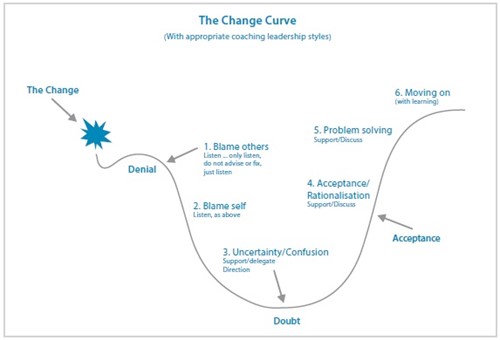Coaching peeps through the change curve
Have you ever encountered the situation where you’ve invested copious amounts of time and energy and possibly money too, to get employees upgrades to the latest systems and processes, you’ve trained everyone and think that therefore all their lives will now be easier. Only to discover, often months later, that people still persist with their old ways, and express discontent with the ‘imposed changes’. Gah, it can be tough and deflating. But here’s why and how to overcome change resistance:
A key factor underpinning individual response to change is personality. So, tools which facilitiate deeeper understandings of the personalities in your team and/or org can assist managers, leaders and coaches to more accurately predict how different personality types are likely to respond to a change or situation, and then deploy the appropriate leadership or coaching style in order to smooth the transition from resistance to acceptance.
Further, many of you will be familiar with the concept of the change curve – it is a popular and powerful model used to understand the stages of organisational change and personal transition. It represents a positive move through stages where positive acceptance is the final outcome. It’s used to help predict how people might react to change, so you can help them to make their own personal transitons, and provide them with the help and support they might need.

However, unless your organisation and leaders actively help move your people through the various stages of the curve, then individuals may become stuck at any stage, thereby making change more difficult (if not impossible).
The 6 key stages of the change curve
Stage 1 begins when a change is first introduced, where people’s initial reaction may be shock or denial. This commonly manifests by blaming others as they react to the challenge of the status quo.
People then move to Stage 2 of the Change Curve: they become critical of themselves.
For the duration that people resist the change and remain at Stages 1 and 2 of the Change Curve, the change will be unsuccessful, at least for the people who react in this way. This is, for many concerned, a stressful and unpleasant stage. It should also be noted that people can waver between these two stages for quite some time.
Stage 3 is where confusion and doubt set it, but it’s a good sign as people are beginning to move on. This manifests in various ways but people will shows signs of doubt and confusion.
Signs of acceptance will, however begin to glimmer through, as they may ask questions such as:
- Do I carry on with my work?
- What will my job be now?
- How do I use this new tech?
At Stage 4 of the Change Curve – Acceptance Rationalisation – people stop focusing on what they have lost. They start to let go, and accept the changes. They begin testing and exploring what the changes mean, and so learn the reality of what’s good and not so good, and how they must adapt. It is useful to be cautious at this stage of people sliding backwards into doubt. This can be common.
By Stage 5, Solutions and Problem Solving, people not only accept the changes but also start to embrace them. they may start to rebuild their ways of working. Only when individuals get to this stage can the organisation really start to reap the benefits of change. It is here that new job descriptions, ideas and innovation can begin to thrive.
Horray – its the stage you’ve been waiting for –Stage 6. The change is now starting to become ‘normal’ or the beginnings of routine and status quo. Learnings can now be captured through a review process and feed into the next cycle of change. Individuals have a greater awareness of how to respond to change and begin to build the personal development aspects of this. Here the changes start to become second nature, and individuals embrace the improvements to the way they work.
As someone managing the change, you’ll finally start to see the benefits you worked so hard for. Your team or organisation starts to become productive and efficient, and the positive effects of change become apparent. Whilst you are busy counting the benefits, don’t forget to celebrate the success! The journey may have been rocky, and it will have certainly been at least a little uncomfortable for some people involved. Everyone deserves to share the success. What’s more, by celebrating the achievement, you establish a track record of success, which will make things easier the next time change is needed.
How to move your peeps through the change curve
Firstly, as mentioned above, everyone has different preferences when it comes to how they like to be communicated with, and how they process information, therefore having an understanding of the different personality types within your team and the human side of change can have an instrumental impact on how you can support them through the change process.
Checklist:
- Have your people been given all the information they would need in order to accept the change and see it as necessary and positive for themselves, their team or the organisation?
- Have you communicated how the inherent risks of change have been considered?
- Have you involved individuals in the change planning and invited their ideas?
- If after intiial seeming acceptance the confusion sets back in, you may need to follow up again with information and coaching that has already been offered in order for the change to take hold long-term.
Coaching Through Change Resistance
Change Curve Stages 1 and 2 – Blaming Self and Others
An easy spot if people are apportioning blame. The style to use here is to simply listen… don’t be tempted to jump in and fix it, don’t offer solutions, and don’t agree with them, just listen. Patience is often the key here….Watch as they move to Stage 2, where again, you just listen. This can take some time, but you need to let them vent.
Change Curve Stage 3 – Confusion
Again this is easy to spot. You’ll probably hear sentiments like: ‘What am I supposed to do with my work?’, ‘Perhaps I should look elsewhere’, or ‘I am not sure of any of this’. The style here is to start giving pointers, start directing them and give some context around the way things will look. It is now your role to ‘sell’ the benefits of the change processes, people, future, and business value. This is appropriate for all of the different personalities.
Change Curve Stage 4 – Acceptance Rationalisation
Here things begin to get easier. This is a good time to get your team to start brainstorming ideas, solutions, and let them know you are supporting them. Watch for individuals who may slip into confusion as they realise they aren’t fully sure of what’s just happened.
Change Curve Stage 5 – Problem Solving
As above, here they start to take ownership for the change. They stop focusing on what they have lost, and start to let go and accept the changes. Individuals begin testing and exploring what the changes mean, and so learn how they must adapt. This is where you stabilise the change.
Change Curve Stage 6 – Moving On
Here the golden question to ask is ‘what have you learnt about yourself and the process you have gone through?’ At this stage, they not only accept the changes but also start to embrace them and begin to rebuild their ways of working. You should now see some benefits coming through from the change.
Summary
As someone needing to 
make changes within your company, the challenge is not only to
get the systems, process and structures right, but also to help and support people through these individual transitions, which can sometimes be intensely traumatic, and involve loss of power and prestige. Remember people will often be at different stages in the curve to you and other leaders. The easier you can make this journey for people, the sooner your organisation will benefit, and the more likely you are to be successful.
If you would like our help embedding change in your business, or helping with personality profiling, please don’t hesitate to get in touch on hello@HROptimisation.co.uk

Hannah Powell
Categories
- Coaching (9)
- CSR (1)
- Culture (1)
- Culture & Engagement (33)
- Diversity and Inclusion (16)
- Employment law (38)
- Inspiration (12)
- Leadership (14)
- Learning & Development (7)
- Recruitment (12)
- Reward (9)
- Self-development (2)
- Tips & tricks (11)
- Uncategorized (18)
- Welfare and Wellbeing (26)
